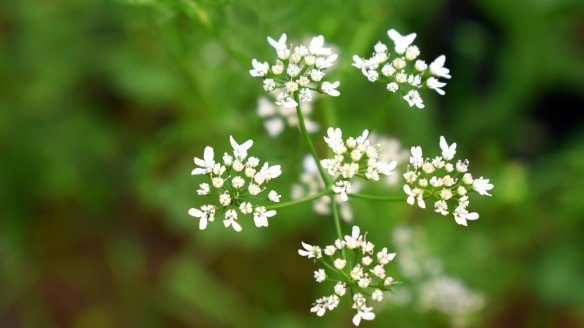Can you eat coriander, flowers, roots and all?

My coriander plant has bolted. Can I eat the flowers? J. Sconce
With the onset of warm weather, annuals such as coriander have a tendency to bolt, or go to seed. I trim the heads off to encourage more leaf. Still, if they do flower, I make the most of the situation by picking the flowers and using them to garnish gin cocktails or a cold chicken salad. Coriander seed is one of the most common botanicals used in distilling gin, adding a bright lemony aroma. These aromas are caused by aromatic compounds or terpenes called linalool and pinene, and account for those pleasant warm, citrus notes that about 80 to 85 per cent of us experience. To the rest of you, coriander tastes like soap. These outliers are sensitive to terpenes, the result of a gene that perhaps once helped our ancient ancestors detect poisonous plants. The ancient Greeks used to think coriander tasted the way bed bugs (koris) smelled, and from that, we get the word coriander. The Spaniards took the same Greek root but ended up with cilantro, an alternative name for the herb used in the US and Latin America. Although coriander is native to Southern Europe, the only traditional cuisine that uses fresh coriander leaves is Portuguese, where it appears in dishes such as bread and garlic soup. Dried coriander seeds are used extensively as a spice. The roots are ground to make curry pastes in Thai cooking, making every part of the coriander plant edible and suitable for cooking. Unless it tastes like soapy bugs to you.
I have pigface growing in the garden. What can I do with it? G. de Korte
When European settler George McCrae arrived in Melbourne, he wrote that the coastal wetlands west of Melbourne were ringed with sapphire-tinged flowers, the clear, still waters broken by fish jumping in the dusk. Those flowers belonged to pigface, an essential source of nutrition for the local Aboriginal people. The wetlands are long gone, filled with rubbish and now a rail yard. But you can still find remnants of those flowering plants along Moonee Ponds Creek. Botanists call it Carpobrotus edulis, but it is sometimes known by an Indigenous name, karkalla, or by its commercial name, sea banana or beach banana. It is a succulent, salt-resistant, drought-tolerant, edible, and high in nutrients. The juicy juvenile leaves can be steamed, sauteed, or served raw in a salad. The exterior skin is oil-soluble so toss the leaves in a little seasoned oil just before serving raw for better texture and flavour. It's perfect with seafood.
Letters
A few weeks back, we were talking about making sausage rolls with sausages. L. Burton wrote, "I use the stuffing from Woolworths caramelised onion sausages, mixed well with a grated onion and caramelised onion from Beerenberg and black pepper." Meanwhile H. Goddard uses chipolatas, skin on, and places them diagonally across a square of puff pastry, wraps them up, brushes with milk glaze and sprinkles with dried herbs. I would argue that is no longer a sausage roll but a chipolata canape, which calls for a glass of pinot noir. And just a quick reminder that November 14 to 21 is Food Safety Awareness Week and there are some courses, information, and a quick quiz available online at foodsafety.asn.au.
Send your vexing culinary conundrums to brainfood@richardcornish.com.au or tweet to @realbrainfood
Appears in these collections
Restaurant reviews, news and the hottest openings served to your inbox.
Sign up- More:
- Restaurant news
